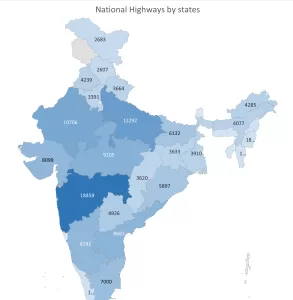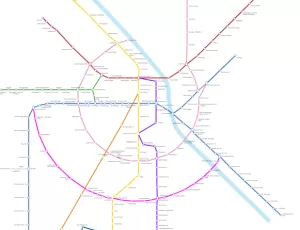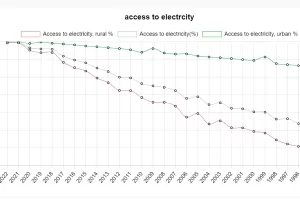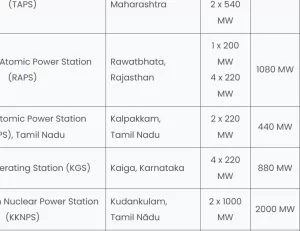Delhi-Mumbai Expressway: Transforming India’s Connectivity
Delhi Mumbai Expressway is India’s longest access controlled expressway which is going to reduce travel time between India’s two megacities from 24 hors to just 12 hours. It is a 1,352 km long, 8-lane-wide expressway, making it the longest expressway in India. According to NHAI nomenclature, it will be known as NE-4.
- Starting Point– DND Flyway
- End point – JNPT, Mumbai
- Length-1352KM
- Lane- 8
- Expressway Name – NE4
- Speed Limit- 120KMPH
- Construction started – Dec 2018
- Completion – 2026(est.)
- Budget – 1,00,000 crores.
- Owner – NHAI
Read also: Noida | Jewar and Navi Mumbai, India’s Two Upcoming Mega Airports
Delhi Mumbai Expressway is a green field expressway which is entirely build on new land. it has provision to expand from presently 8 lanes to 12 lanes.
Route and connectivity
States covered
| State | Length covered(KM) |
|---|---|
| Delhi | 12 KM |
| Haryana | 126KM |
| Rajasthan | 373 KM |
| Madhya Pradesh | 244 KM |
| Gujrat | 426 KM |
| Maharashtra | 171 KM |
Expressway is covered by total six numbers of States.
Major Cities Connected by the Delhi-Mumbai Expressway
The Delhi-Mumbai Expressway is a game-changer in India’s transportation network, boosting connectivity across northern, western, and central India. This high-speed corridor links key economic, industrial, and tourism hubs, significantly reducing travel time and fostering regional development.
Key Cities Along the Delhi-Mumbai Expressway
Delhi
- Starting point of the expressway and India’s national capital.
Haryana
- Gurgaon, Faridabad, Ballabgarh, Sohna – Thriving business districts and residential hubs.
Rajasthan
- Jaipur – Capital city, major center for tourism and industry.
- Alwar, Dausa – Renowned for cultural heritage and tourism.
- Sawai Madhopur – Home to the famous Ranthambore National Park.
- Kota – A leading education and industrial hub.
Madhya Pradesh
- Garoth, Mandsaur, Jaora, Ratlam, Thandla – Important agricultural and industrial centers driving regional growth.
Gujarat
- Dahod, Godhra – Enhancing connectivity in tribal and rural regions.
- Vadodara, Bharuch, Surat – Major industrial and economic cities, key contributors to India’s GDP and trade.
- Navsari, Valsad, Vapi – Notable for industrial parks and proximity to the Arabian Sea.
Maharashtra
- Virar, Mumbai – Mumbai, India’s financial capital, is the final destination of the expressway.
- JNPT (Jawaharlal Nehru Port) – One of India’s largest container ports, vital for international trade.
Read also: Noida International Airport (Jewar Airport) : An Overview
Sections in Delhi Mumbai Expressway
- DND-Faridabad-KMP
- Sohna–KMP–Vadodara
- Vadodara–Virar
- Virar–JNPT
Spurs
Bandikui – Jaipur expressway: 4 lane, 67 KM expected to ready by Dec 2024.
Faridabad–Jewar–Khurja Expressway: 6 lanes, 30 KM road to connect Jewar airport to Delhi-Mumbai Expressway in Faridabad.
Garoth – Ujjain spur: 6 lanes 130 KM road to connect Ujjain and Indore to the expressway.
Facilities
India’s Longest expressway will have several world class features and facilities to ease to the travel of commuters such as hotels, petrol pumps, Hospitals, restaurants etc.
Road side amenities
The expressway will have total 93 numbers of road side amenities with facilities like restaurants, shopping outlets, ATMs, Petrol pumps, Gas pumps, electric charging stations, washrooms, trauma centers etc.
Security cameras
- Expressway to have one security camera every kilometer of the road. it will help NHAI to manage the traffic.
- The road will have speed camera to detect the overspeed of the vehicles. it will help in E challan system for over speeding vehicles.
Connectivity
The Delhi Mumbai expressway is going to be the largest expressway in India, it will pass through 6 states and many cities, it is part of Delhi Mumbai Industrial corridor and will help to boost economy of those cities.




